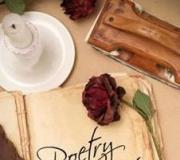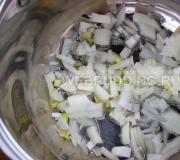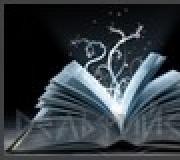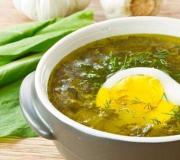Drawing with crumpled paper. Unconventional technique of drawing with crumpled paper
Goal: to expand teachers’ knowledge about non-traditional methods of drawing, namely, drawing with crumpled paper. Objectives: - to introduce special knowledge and practical skills in the field of visual arts unconventional ways drawing; - increase the level of teachers' skills.

Unconventional drawing attracts with its simplicity and accessibility, reveals the possibility of using well-known objects as art materials. And the main thing is that unconventional drawing plays important role All in all mental development children. After all, the main thing is not the final product - a drawing, but the development of personality: the formation of self-confidence, in one’s abilities, and purposefulness of activity. Non-traditional techniques allow you to express feelings and emotions in drawings, give the child freedom and instill confidence in their abilities. Owning different techniques and ways of depicting objects or the surrounding world, the child gets the opportunity to choose.

Visual activities using non-traditional materials and the technician contributes to the development of the child: Fine motor skills and tactile perception; Spatial orientation on a sheet of paper, eye and visual perception; Attention and perseverance; Thinking; Fine skills and abilities, observation, aesthetic perception, emotional responsiveness; In addition, in the process of this activity, control and self-control skills are formed.

Drawing with crumpled paper The first method: crumple a sheet of paper, straighten it, draw the intended design with any colors. On the folds, the paper absorbs paint more strongly, resulting in interesting effect mosaics. The second method: crumple a piece of paper, dip it in paint and paint using the “lure” method.









Elena Panina
Target: introduce children to unconventional technology drawing: drawing with crumpled paper.
Tasks: develop creativity, interest in drawing, develop imagination, thinking, fine motor skills and hand coordination. Develop aesthetic perception, fantasy. Foster independence, activity and accuracy in work.
Drawing with crumpled paper- this is very interesting and unusual drawing technique. It gives children room for imagination and excellent gymnastics for children's hands and fingers.
Even the process of preparing for a lesson becomes unusual, interesting and exciting.
Preparation paper making lumps is a fascinating activity and children can easily and happily handle it themselves.

After you have prepared all the supplies occupation: paints, jars, paper, containers in which you can dilute paints, brushes, rags. It is necessary to think through the details of the future drawing. Try to reproduce the drawing.
The most important thing in this type of creativity is imagination. It depends on your imagination what it will look like final result drawing.
When discussing the upcoming work, the children and I discuss small and large parts drawing, which means paper we will need lumps large and small sizes. Accordingly, the prints from them will vary in size.




As a result looms invented by children painting:



In our work we use brushes to draw or complement the elements of the picture. Therefore, the drawings turned out to be combined.

Now I suggest you look at some of our work:







This is how we met unconventional drawing technique -"crumpled paper".
Publications on the topic:
Drawing is fun and exciting activity. One of the very first tools with which you can create colorful and original.
Master class for teachers “Unconventional drawing technique “scratch” The purpose of the master class: to increase the desire of teachers to master the new non-traditional drawing technique “scratch”. Objectives of the master class: 1. Introduction.
"BOUQUET OF LILAC" Dear colleagues, I would like to present to your attention a master class on unconventional drawing techniques. In my work I.
It is in creativity that you can give your child room for self-expression: help him choose what to draw, what to draw on and how to draw. Nothing.
Master class “Unconventional technique of painting with sand on glass” Slide 1: Dear colleagues! I present to your attention a master class “ Unconventional technique drawing with sand on glass." Slide 2: According to.
Drawing using non-traditional painting techniques fascinates, calms and captivates children. This is a free creative process.
Master class on group work “Non-traditional drawing techniques” Master class on group work “Non-traditional drawing techniques” I, Tatyana Leonidovna Parnacheva, teacher of Kindergarten No. 1, attended.
Children and creativity are inseparable concepts. The child learns the world, trying to reflect it in play, modeling and drawing. After all, at heart, every child is a singer and musician, artist and sculptor. Creative impulses in children are often associated with artistic activity, A fine arts child is an ideal opportunity to express his imagination. This is an important condition for the normal development of the baby.
Non-traditional drawing techniques for children in kindergarten and school - this does not mean something complicated. Quite the opposite - such drawing turns an art lesson into fun fun. Here it is not at all necessary to have complex pencil and brush skills. IN simple techniques non-traditional drawing, a child is able to create beautiful drawings and paintings, and this will give him an amazing creative experience with an excellent final result. He himself will be drawn to art when he feels that he can create beauty with his own hands.
Unconventional drawing methods
For children, non-traditional drawing techniques are a wonderful way to create small masterpieces. It turns out that your palm can turn into a pink elephant, a simple blot can become a tree, and a carrot and potato can surprise you with unusual patterns.
Eg, kids 3-4 years old we can suggest:

With kids 5-6 years You can also try:
- prints-pictures

- plasticine printing

- leaf prints

- palm drawings

- painting with cotton swabs

- magic strings

- monotype.

And with children 7-8 years You can master more complex techniques:
- drawing with crumpled paper

- drawing soap bubbles

- painting with salt

- blotography

- plasticineography

- grattage

- frottage.

For children, modeling from plasticine is a whole world full of variety and experiments! Under your sensitive leadership a child can make all sorts of things and will become the most the best leadership to create various fairy-tale heroes, animals and plants.
Hand drawing
Drawing with pens is the first technique that little children can master very early. The drawing turns out quickly - this is extremely important, because kids cannot do one thing for a long time. Dip a child's hand in paint and let the child make an imprint on the surface of the paper. See what it's like. Ask your little one what needs to be completed to make an animal or bird. The missing details can be drawn with your fingers. 
Techniques for painting with watercolors on wet paper
To create small masterpieces you will need a sheet of thick paper, watercolor paints and a brush. Help your child wet the sheet evenly, but make sure there are no puddles. Let him put some paint on his brush and start creating. Each stroke spreads across the paper in a new tone, beautifully transitioning into a different shade. Now is the time to show your child how colors are mixed and explain what shades are.
Tell your child that all movements should be done easily and smoothly; there is no need to press the brush into the paper, as many children like to do. A light touch is enough. This technique works well for drawing backgrounds. And after drying, you can continue to draw the rest of the drawing.


Drawing using the Glue Pictures technique
To draw in this style you will need a glue gun. Help your child draw outlines on paper with hot glue and fill in the image with paint. Thanks to the glue, the paint does not flow beyond these contours. It turns out something like a stained glass image. Using this technique, you and your child can create a real stained glass window on glass, but then instead of a simple watercolor you will need to buy acrylic paints water based. 
Traditionally, on New Year's Eve, kindergartens hold exhibitions of bright crafts and creative works kids who decorate the kindergarten at the most magical days New Year's holiday. We offer you a variety of .
Watercolor drawings with wax crayons
To draw a picture using this technique, you need: a landscape sheet, wax crayons, watercolor paints, a squirrel brush, leaf templates.
Let the child, with your help, draw several different leaves. The drawing must be arranged according to the size of the leaves - first large, then smaller. Let the leaves overlap each other - this is how nature does it.
Now take wax crayons and trace the outlines of the leaves, for this you will need crayons warm shades: yellow, red, orange, brown, burgundy. You can use several colors in one sheet. Don't forget to draw veins on each leaf, except rowan ones
Interesting! How to make a crown for a little princess for the New Year 2019
Now is the time to take advantage watercolor paints- start painting not the leaves, but the landscape sheet from the upper left corner. Show your child how to add other colors so that one shade flows smoothly into another without clear boundaries. In this way we gradually fill our sheet with autumn colors.









Drawing with fun prints
1. Plasticine stamps
It is very simple and convenient to make stamps from plasticine - just give it a piece of plasticine the required form, decorate with patterns (lines, dots) and paint in the required color. 
2. Thread stamps
To create interesting “striped stamps” you can use threads that need to be tightly wound around an object. Then the threads are painted with thick paint in the required color. Now only imagination will tell you how to apply a “striped pattern” to the surface of the paper. 
3. Stamps made from folded cardboard
By rolling a piece of cardboard into a roll, you can get an original stamp for “roses”. And if you cut a “round piece” from a toilet paper roll and give it the shape of a leaf, then your child can create a beautiful composition on his own. 
4. Leaf prints
This technique is familiar to many. To stamp a leaf, you can take any pretty leaf and apply ink to the side with the veins. Then apply the painted side of the sheet to the paper and iron it. After a few seconds, you can carefully lift the leaf - its imprint will remain on the paper. 
5. Prints with potatoes, carrots, apples
For kids early age This is a fairly popular technique. You will need any vegetable or fruit and gouache. Then everything is simple - dip the object in paint and make an imprint on paper.
Stamps can be made from apples, potatoes, carrots, peppers and other vegetables or fruits. The easiest way is to make a stamp from potatoes. if you have metal molds To cut out the cookies, simply press the mold into the potatoes and carefully trim the excess pieces around the edges with a knife.




Drawing with soap bubbles
It will be very interesting for the child to draw a picture with soap bubbles. To do this, add any soap solution and paint to a glass of water and use a straw to make a strong foam. Carefully place a sheet of paper on the bubbles and wait for the first patterns to appear. You can lift the paper - the bubble patterns are ready. 


Painting with salt
To add a whimsical texture to the background of your painting, you can use salt when depicting any landscape. While the paint has not yet dried, the background must be sprinkled with salt. It absorbs excess water, sticks and creates a very interesting effect. Excess salt should be carefully shaken off after drying. Unusual light spots will remain in its place.


There is another extraordinary interesting option drawing with salt. To do this, you need to draw a picture with a pencil, and then circle it with PVA glue. It can be a simple flower, patterns or geometric shapes. We don't regret glue. Sprinkle the design generously with salt, and then carefully shake off the excess onto the tray. Now let's add colors - you can paint with a brush, or you can take a pipette and apply colored water drop by drop onto the drawing. You will be able to see how the drops spread and create bright patterns and shapes. 



Drawing with crumpled paper.
Using a crumpled napkin or paper you can create an unusual texture. There are two ways to do this technique:



Monotype
This unusual technique drawing is based on a unique print, which can only be obtained in a single copy. Therefore, it is impossible to create two absolutely identical drawings.
I. Using various materials while drawing, you can achieve interesting effects:
1. to get blurry outlines, drip water (or vodka) onto a sheet covered with watercolors. This is a good way to depict a sky overcast with clouds;
2. effect "cereals", snowflakes, "ice crust" can be obtained by sprinkling salt on the applied watercolor image;
3. chaotic uneven retouching turns out thanks to crumpled paper;
4. drawing with a stencil has many options. Try placing the cut out figure on a piece of paper and covering them with watercolors. Now remove the stencil, allowing the paint to spread out. The outlines of the stencil image will be blurry, and the color will intensify from the center of the figure to the periphery;
5. interesting texture can be achieved using sandpaper;
6.emerging "second" layer possible with multilayer image. Draw crayons or candle something on a piece of paper and cover it with watercolors. In those places where something is drawn with chalk or a candle, the paint will not lie smoothly, and the image will show through from under it;
7. "scratching" paint paintings. Draw something crayons or candle on paper (or just color the sheet with crayons). Now cover the sheet of paper with the image with a thick layer of paint (gouache) and let it dry. After the paint has dried, you can start scratching out the image. In those places where there is chalk, the paint will come off well, in other places it will remain an even background;

8. one more interesting way drawing crayons and gouache can be called " m1st image". Wax crayons An object is drawn on paper, and the entire space around it is also painted over with crayons. Now we carefully crumple this sheet, straighten it and cover it with gouache. Now quickly wash off the gouache using a sponge and water. The paint should remain only in the places where the paper is folded;
9. an interesting effect is obtained from drawing sponge. Invite your child to “draw” the crown of trees or the sea with a sponge;

10. give "fluffiness" image can be used using gauze or cellophane. It works well to use this effect with stencil. Cut out an animal figure from cardboard and attach it to a sheet of paper. Now we dip gauze or cellophane into paint diluted with water and lightly move along the contour of the stencil. When you remove the stencil, you will see a clear figure of the animal, and its outline will look soft and fluffy (for example, like a bear drawn with gauze by Valeria Koryavikova).
Next to it is a drawing made according to the same principle, only without a stencil, and instead of gauze was used polyethylene bag;

11. try using it as an additional drawing tool threads. Good at drawing winding lines using woolen threads from a loose product;
12. amazing colorful circles are obtained if you paint not with a brush, but electrical toothbrush or massage brush.
II. "Punching": the child might like it" stamp" objects or in this way "draw" something. You can "stamp" any objects, these can be cubes (a set geometric shapes) or eraser on the back of the pencil: 

Prints can be made natural materials, For example, spruce branch or a large leaf from a plant:




III. The baby may like to draw on a sheet if it lies on some convex surfaces. You can make a curly one yourself stencil For "imprints", for example, like this:
IV. If you draw over a wet watercolor drawing reverse side tassels, then you get " grooves", as in the picture with the trees.  So you can “draw” on the wet one with scissors, in which case the “grooves” will be the same and two at a time.
So you can “draw” on the wet one with scissors, in which case the “grooves” will be the same and two at a time.
V. Spray: Interesting effects and images can be created by spraying paint from a brush or toothbrush onto a sheet of paper. The same can be done by placing an object on the sheet. Then there will be a “dotted background” around the object, and the image of the object will be colorless.

With help splash you can paint the whole picture:

VI. Blots: drop and let the paint spread over the sheet. You can blow into the center of the blot through a straw. You can make images from blots mirrored, if you first fold the sheet in half (or twist it), then straighten it and drip paint onto it. Now fold the sheet again and press lightly. Next is a matter of your imagination. See what the blots look like and add the necessary details. Below is a mirror drawing from a blot by Yulia Mitko. 
VII.Monotype. This technique works well for postcards.Apply multi-colored stripes or patterns to glass (or any other material that does not absorb paint). Now place a sheet of paper on top and press down lightly. Remove the sheet of glass and examine the printed design.
 |
 |
VIII.Foam drawing.
1. Whisk foam and pick it up with a sponge. Now squeeze out the sponge so that the foam ends up in the paint container. Stir and use a brush to apply foam and paint onto the paper. When the drawing is dry, the excess foam can be blown off.
2. For creating effect use different shades take the colors shaving foam and gouache of the color you need. Mix shaving foam and paint in a bowl and apply it to the drawing with a brush.
IX. Drawings with glue
1.Glue lining.Draw an object on the sheet with a pencil. Through small hole In a tube of stationery glue, squeeze the glue along the contour of the image and leave it to dry. Then fill in the space inside the outline.
Ekaterina Luchkina
The master-class is intended for kindergarten teachers, parents and children. Children's age is 5-7 years.
Target: introducing children to technology drawing on crumpled paper.
Tasks:
Develop fine motor skills of the hands.
Development creativity in preschool children;
Bring up careful attitude to nature;
Development of attention, thinking and taste;
Cultivate accuracy when working with paints
To work you will need:
Watercolor paints
The brush is soft (number of your choice)
Sheet A4 paper
Jar of water

Sheet crumple up the paper, but carefully so that it does not tear.

Then we spread the sheet on the table with our palms

Let's get started drawing with paints. We need watercolor because it requires a lot of water, unlike gouache. And this work will require a lot of water.

You need to use a lot of water and a lot of paint on your brush. Their excess will flow into the folds. And after drying, the folds will become brighter and more beautiful. Gradually, detail by detail we draw a mountain landscape.

The work is ready! Try it with your children, I hope they will find it interesting!
Publications on the topic:
Not so long ago, on one of the sites, I spied a very interesting view work. I don’t know what this technique is called correctly, but with children.
Walking along the shore of the Black Sea, I peered intently at the pebbles lying under my feet. Each one is different from the other, each one is special.
Master Class " Maple leaves from crumpled paper" Each season is beautiful in its own way... Autumn is the time multi-colored paints. Inspired.
Dear Colleagues! Quite by accident, I took an unconventional drawing course (sand painting). After them, I got excited about the idea of making it happen.
I would like to offer you a master class “Drawing with threads”. It’s a painstaking, but very exciting task; it took a lot of time to make our paintings.
Threadography, drawing with thread - simple and affordable way Images. But its unpredictability captivates and fascinates. I want it many times.
When working with children, we often use both traditional and non-traditional drawing techniques. Once, having attended an art therapy course,...
Educational field: “Artistic and aesthetic development” Drawing on crumpled paper “Snowdrop” Topic: “Snowdrop” Goal: development fine motor skills non-traditional drawing techniques. Objectives: to strengthen children’s classification skills.






